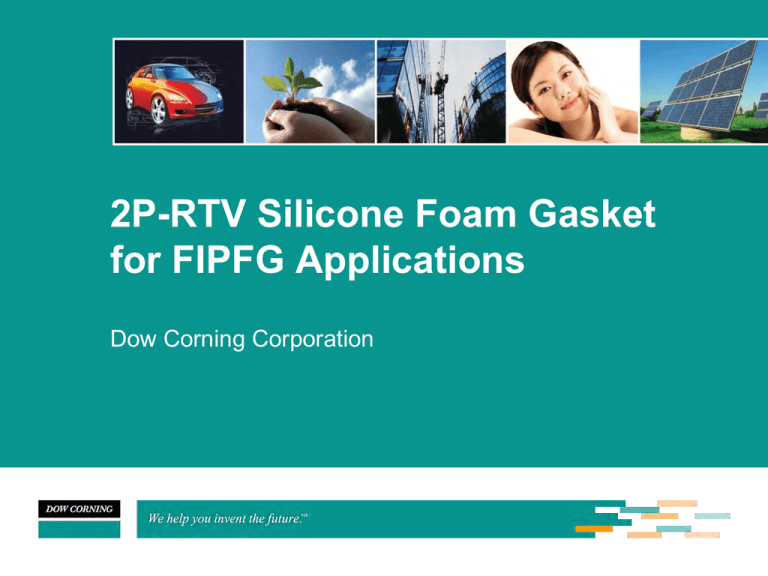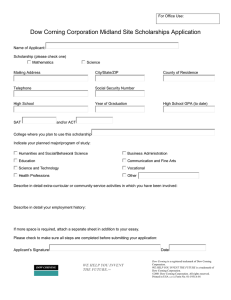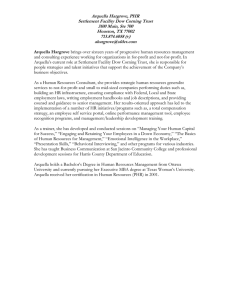
2P-RTV Silicone Foam Gasket
for FIPFG Applications
Dow Corning Corporation
Presentation topics
1.
Dow Corning silicone foams: Appearance / samples
2.
Dow Corning FIPFG applications
3.
Dow Corning FIPFG processing
4.
Curing of Dow Corning silicone foams
5.
Product properties of Dow Corning silicone foams
2
1. Dow Corning silicone foams: Appearance / samples
3
1. Dow Corning silicone foams: Appearance / samples
Silicone
Adhesives/Sealants
RTV
HTV
Heat Cure
Materials
1-part RTV
2-part RTV
1-part Heat Cure
Moisture Cure
No Moisture Cure
Adhesives
Acetoxy Cure
Oxime Cure
Alkoxy Cure
2-part Heat Cure
Alkoxy Cure
Silicone Reactive
Hotmelt
Silicone Foam
2-part CIPG
Compression Gaskets
Adhesives
Addition Cure
Condensation Cure
Room Temperature
Vulcanizing
Products
Cured In
Place Gaskets
4
2. Dow Corning FIPFG applications
Ideal for use when:
•
A compression gasket is required
•
An “environmental seal” is required
(sealing against ambient air, splashed water, dust, moisture)
•
A cost effective sealing solution is required
(compared to preformed gaskets / foam tapes)
•
High tolerance gaps exist
•
Low sealing force / low modulus is required
•
Component sound and vibration requires dampening
•
Gasket installation demands automation (robotic dispensing)
•
Serviceability is an issue
•
Installation at tiered supplier is preferred
•
Fast-cure (room-temp / low heat) is demanded
5
2. Dow Corning FIPFG applications
•
Back caps for head lamps / tail lights
•
Head lamps / tail lights / break lights
•
Housings for electric devices
•
Timing belt cover
•
Plastic cover under the Bonnett (“Beauty Covers”)
•
Door modules
•
Almost anywhere foam tape is used !
6
2. Dow Corning FIPFG applications
•
Supporting metal frame of ceramic hobs
•
Ceramic hobs
•
Dishwasher detergent dispenser unit
•
•
Outdoor lighting
Gas boiler
7
3. Dow Corning FIPFG processing
•
A two part silicone RTV foam is directly dispensed onto the part surface to be sealed
•
Once the components are mixed, a foaming agent (H2) is formed
•
The dispensed foam gasket expands in its liquid stage and cures to a foamed solid
(elastomere) within 10 minutes at room-temperature.
•
Provides a low modulus integrated compression seal with fine cell-structure
A
B
Mixed & dispensed
liquid components
(no bubbles)
Expanded & cured solid
(elastomer with bubbles)
8
3. Dow Corning FIPFG processing
1. Application
Robotic application
of 2-part RTV
silicone foam
2. Curing at RT
3. Finished Part
4. Assembly
Expansion of
the gasket
Part can be
handled after
approx. 10 min.
Part can be
assembled after
15 min., preferably 1h
(optional at elevated temp.)
~1h
A
B
~3-5 min
> 10 min
9
3. Dow Corning FIPFG processing
Dow Corning DFG products are being applied via
commercial available meter-/mix units directly
onto the part to be sealed. The meter-/mix
equipment consists out of:
Dispensing unit
Pressurized tanks or recirculation
Conditioning unit
• Product supply pumps, incl. refill unit
• Product conditioning unit
(air nucleation, recirculation)
• Metering pumps (precise flow control)
A
B
• Mixing chamber (dynamic or static)
Gear
pumps
• Robot (6-axis robot or xyz-table)
• Parts conveyor belt or shuttle table
• Part fixturing
Mixer (dynamic or static)
Heating tunnel
(optional)
Conveyor
belt
Part loading
Robotic
application
Finished
parts
10
3. Dow Corning FIPFG processing
Static mixing
Dynamic mixing
•
Cheaper equipment
•
•
No solvents required
Mixing efficiency depends on ratio shear to
friction
•
Mixer is easily moved around
contoured parts
•
•
Process conditions very much depend
•
on product temperature and
throughput
•
Typically components are “preconditioned“
(temperature controlled, pre-loaded with
dry air)
•
Production process more critical due
to issues of purging to waste and
dripping
•
More robust and flexible process
Less waste during production stops
Higher capital investment
Dynamic static mixing
•
The two components are mixed via
“rotating static mixer elements“
•
In between static and dynamic mixing
process
•
Higher throughput than static mixing
•
Less expansive than dynamic mixing
11
4. Curing of Dow Corning silicone foams
Once the components A&B are mixed, the
following reactions occur:
1. Hydrogen Formation
2. Formation of gas cells and cell growth
(Foam Expansion)
3. Curing (Formation of the elastomeric
network)
All reactions are temperature dependent, but
at different rate constants.
To ensure a homogeneous cell size
distribution, a proper mixing of the components
is essential.
12
4. Curing of Dow Corning silicone foams
Foaming mechanism
Si-OH
R-OH
+
Si-H
Si – O – Si
R – O – Si
+
H2 ↑
•
Dow Corning DFG products create the foaming gas during the crosslinking reaction
(hydrogen as by-product)
•
Typical amount of H2 evolved: 0.5 - 1.3 g / kg Product
•
Typical expansion ratio: 1:2.5 to 1:4
•
To ensure optimal foam structure a good mixing of the components is required
•
In case of dynamic mixing air nucleation is typically recommended
13
4. Curing of Dow Corning silicone foams
Curing mechanism
Si-CH=CH2 +
Polymer
Si-H
Crosslinker
“Pt”
Si-CH2 - CH2-Si
3 dimensional network
Elastomere
•
Dow Corning DFG materials are addition cure products containing Pt-catalysts
•
Certain chemicals, curing agents and plasticizers can inhibit cure
•
These include:
– Sulphur / Polysulphones / Polysulfides / Sulphur containing materials
– Organo-tin compounds / silicone rubber containing organo-tin catalysts
– Amines / Amides
– Urethanes
– Azides
14
5. Product properties of Dow Corning silicone foams
Typical product properties
Product
Property
8257
8257
black
3-8209
3-8219 RF
3-8259 RF
3-8259 RF
dark grey
Viscosity
[mPas]
A: 21000
B: 12000
A: 20000
B: 12000
A: 14000
B: 15000
A: 21000
B: 40000
A: 68000
B: 63000
A: 64000
B: 62000
Snap time
[s]
230
240
220
200
200
200
8
8
7
6
7
6
140
150
250
300
330
330
flowable
flowable
flowable
17
15
16
Cell structure
[Zellen/3cm]
35
30
fine
fine
fine
fine
Hardness
Shore 00
25
25
45
45
50
50
Tack free time
[min]
Density
[kg/m³]
Flowability
[cm]
15
5. Product properties of Dow Corning silicone foams
Influence of flow characteristics on the aspect ratio
Material as
dispensed
Cured gasket
Flowable foam
e.g. 3-8209
h/b ratio ~ 1/3
Reduced
flowable foam
e.g. 3-8259 RF
h/b ratio ~1/2
16
5. Product properties of Dow Corning silicone foams
Difference of flowable and reduced flowable foams
17
5. Product properties of Dow Corning silicone foams
Compression set / compression stress relaxation
A C
CompressionSet %
100
A B
A C (after test)
A = Sample Height before Storage
B = Sample Height under Compression
C = Sample Height after Storage
B
18
5. Product properties of Dow Corning silicone foams
Compression set / compression stress relaxation (CSR)
F
100
CSR %
F
after
before
Fafter = Counterforce after Storage
Fbefore = Counterforce before Storage
19
5. Product properties of Dow Corning silicone foams
Compression set / compression stress relaxation (CSR)
22h / 70°C / 50% compression
Property
Product
Comp. Set [%]
NPC
Comp. Set [%]
PC 1h 100°C
CSR [%]
NPC
CSR [%]
PC 1h 100°C
8257
77
9
78
83
8257 black
69
8
79
84
3-8209
32
4
85
88
3-8219 RF
24
5
86
87
3-8259 RF
16
5
87
85
3-8259 RF dark grey
15
4
89
86
20
5. Product properties of Dow Corning silicone foams
Compression stress deflection
•
According to:
DIN EN ISO 3386-1
•
Setup values:
Compression of 70% in 4 cycles with a specified speed
•
Measured values:
Stress as function of compression
•
Result values:
1. Diagram stress against compression
2. Stress measured during the 4th cycle at 40% compression
21
5. Product properties of Dow Corning silicone foams
Compression stress deflection
22
5. Product properties of Dow Corning silicone foams
PC 1h 100°C
NPC
23
5. Product properties of Dow Corning silicone foams
DMTA dynamic mechanical thermal analysis
•
Dynamic means
-> stress on sample is oscillating
•
Mechanical means
-> stress on sample is compression (or tensile or shear …)
•
Thermal means
-> test runs with temperature profiles
→ it applies ...
an oscillating compression
→ it measures ...
the resulting forces / stress
Storage Modulus
it‘s a value for elastic behavior
Loss Modulus
it‘s a value for viscos behavior
Loss Factor tan
it‘s the relation between loss & storage modulus
24
5. Product properties of Dow Corning silicone foams
DMTA Temperature sweep
25
5. Product properties of Dow Corning silicone foams
Adhesion of Dow Corning silicone foams
•
DFG materials generally do NOT develop adhesion to metal and plastic substrates
•
If higher degree of adhesion is required, surface treatments such as cold plasma,
corona, primer or flame treatment are recommended
•
Part design considerations such as grooves and channels can also improve adhesion
(mechanical stay-in-place adhesion due to expansion of gasket bead)
•
Adhesion may be less successful on low energy plastics such as polyethylene or PTFE
26
The information contained in this communication does not constitute an offer, does not give rise to binding obligations, and is
subject to change without notice to you. The creation of binding obligations will occur only if an agreement is signed by authorized
representatives of Dow Corning and your company. Any reference to competitor materials contained in this communication is not
an endorsement of those materials by Dow Corning or an endorsement by the competitor of Dow Corning materials.
To the fullest extent permitted by applicable law, Dow Corning disclaims any and all liability with respect to your use or reliance
upon the information. DOW CORNING DOES NOT MAKE ANY WARRANTY OR REPRESENTATION, EXPRESS OR IMPLIED,
WITH RESPECT TO THE UTILITY OR COMPLETENESS OF THE INFORMATION AND DISCLAIMS THE IMPLIED
WARRANTIES OF MERCHANTABILITY AND FITNESS FOR A PARTICULAR PURPOSE. DOW CORNING DISCLAIMS
LIABILITY FOR ANY INCIDENTAL OR CONSEQUENTIAL DAMAGES.
Dow Corning is a registered trademark of Dow Corning Corporation.
© 2016 Dow Corning Corporation. All rights reserved.
Form No. 80-4044A-01
27



